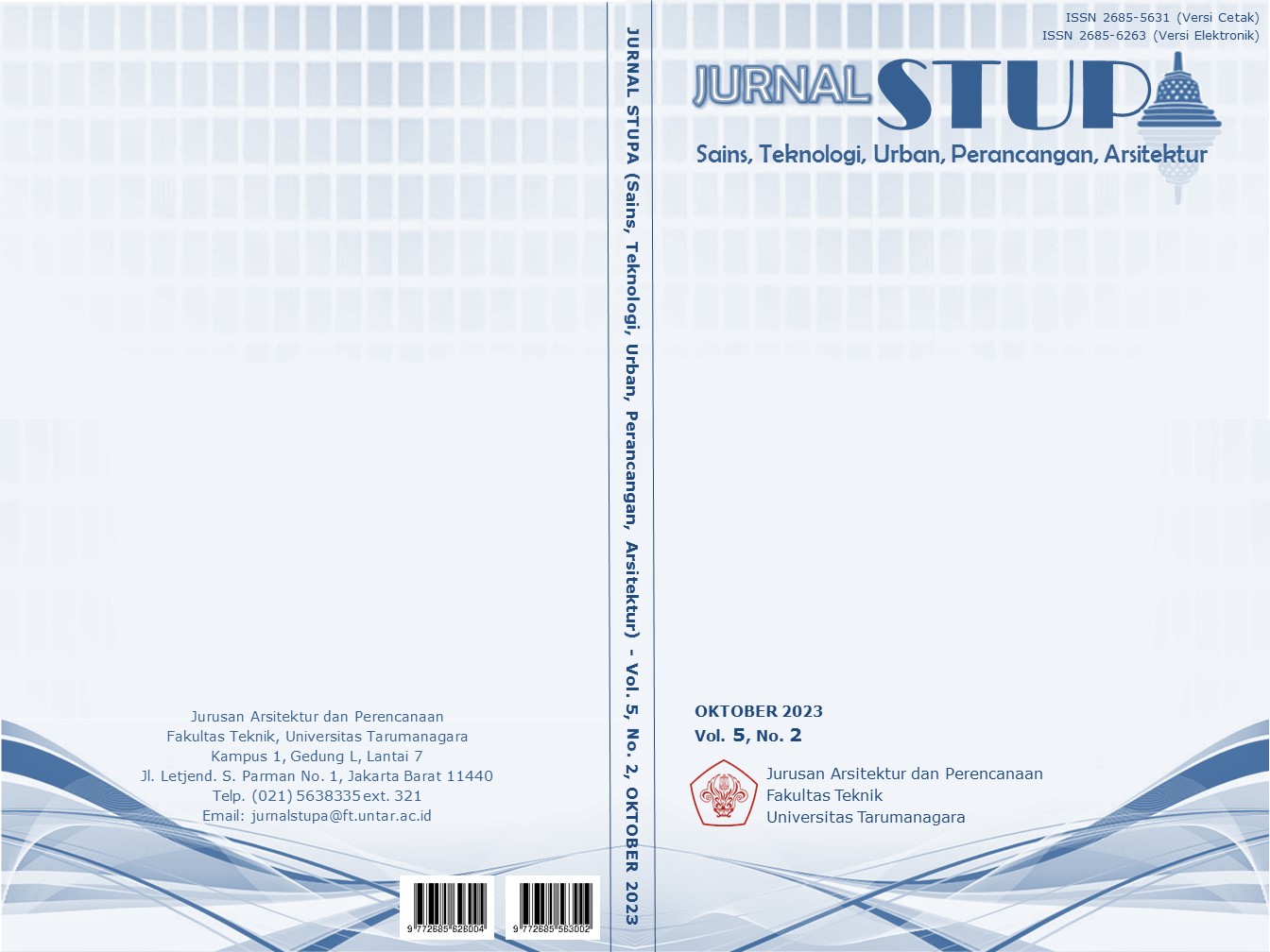DESAIN PROTOTIPE SEKOLAH DASAR ANTI-PERUNDUNGAN MELALUI PENDEKATAN ARSITEKTUR EMPATI DAN PERILAKU
Isi Artikel Utama
Abstrak
Most cases of bullying occurred in schools at the elementary level. This happens because most of the child's time is spent at school. This paper is about research in finding criteria for anti-bullying school prototypes. From an architectural point of view, negative space can influence a person's negative behavior. Some of the location points that are in the spotlight are the stairs, toilets, corridors, canteens, and classrooms. The data used in this study are secondary data obtained through interviews with psychologists, literature, and case studies. The data is used to design prototypes of school spaces that can help prevent cases of bullying. With this issue, the method that will be used is the architectural method of empathy, behavior, and psychology. These three deisgn methods are used with the aim of creating a school environment that avoids the creation of negative spaces so that bullying behavior can be controlled architecturally and the environment created feels safe as well as fun for children. The result of this study is a prototype of an anti-bullying elementary school that has the characteristics of a safe and comfortable environment for students. The elementary school environment is designed in such a way as to pay attention to social interactions between students, reduce negative spaces, and all rooms get passive supervision. In addition, social spaces are also designed to facilitate activities that can reduce stress and improve students' mental health as well as provide a place for parents in the school environment.
Keywords: anti-bullying space; behavioral architecture; empathy architecture; negative space; prototype elements
Abstrak
Kasus perundungan terbanyak terjadi pada sekolah di tingkat SD (Sekolah Dasar). Hal ini terjadi karena sebagian besar waktu anak dihabiskan di sekolah. Tulisan ini berisi tentang riset dalam mencari kriteria desain prototipe sekolah anti-perundungan. Dari segi arsitektur, ruang negatif dapat mempengaruhi perilaku negatif dari penghuninya. Beberapa titik lokasi yang menjadi sorotan adalah tangga, toilet, koridor, kantin, dan ruang kelas. Data-data yang digunakan dalam penelitian ini adalah data sekunder yang diperoleh melalui wawancara dengan ahli psikologi, literatur, dan studi kasus. Data tersebut digunakan untuk merancang prototipe ruang sekolah yang dapat membantu mencegah kasus perundungan. Metode yang akan dipakai adalah dengan menggunakan pendekatan arsitektur empati, perilaku, dan psikologi. Ketiga pendekatan desain ini dipakai bertujuan untuk menciptakan suatu lingkungan sekolah yang menghindari terciptanya ruang negatif sehingga perilaku perundungan dapat dikontrol secara arsitektural serta lingkungan yang diciptakan terasa aman sekaligus menyenangkan bagi anak-anak. Hasil dari penelitian ini adalah sebuah prototipe sekolah dasar anti-perundungan yang memiliki karakteristik lingkungan yang aman dan nyaman bagi para siswa. Lingkungan sekolah dasar dirancang sehingga memperhatikan interaksi sosial antar siswa, mengurangi ruang-ruang negatif, dan seluruh ruangan mendapatkan pengawasan pasif. Selain itu, ruang-ruang sosial juga dirancang untuk memfasilitasi kegiatan yang dapat mengurangi stres dan meningkatkan kesehatan mental para siswa serta menyediakan tempat bagi orang tua siswa di lingkungan sekolah.
Rincian Artikel

Artikel ini berlisensiCreative Commons Attribution-NonCommercial-ShareAlike 4.0 International License.
This work is licensed under a Jurnal Sains, Teknologi, Urban, Perancangan, Arsitektur/ STUPA Creative Commons Attribution-NonCommercial-ShareAlike 4.0 International LicenseReferensi
Birren, F. (1950). Color Psychology and Color Therapy. Citadel Press.
Day, C., & Midbjer, A. (2007). Environment and Children: Passive Lessons from the Everyday Environment. London: Elsevier Ltd.
Glover, D., Gough, G., Johnson, M., & Cartwright, N. (2010). Bullying in 25 secondary schools: incidence, impact and intervention, 42.
Lines, D. (2007). The Bullies: Understanding Bullies and Bullying. Jessica Kingsley Publishers.
Mengawasi. (t.thn.). Diambil kembali dari Kamus Besar Bahasa Indonesia.
Migliaccio, T., Schmidtlein, M., & Raskauskas, J. (2017). Learning Environment. Mapping the landscapes of bullying.
Nuraini, R. (2008). Perilaku Bullying di Sekolah Menengah Pertama. Skripsi di Jurusan Psikologi Pendidikan dan Bimbingan UPI Bandung.
Pepler, D. J., & Craig, W. (2014). Bullying prevention and intervention in the School environment: Factsheets and tools.
Rapp-Paglicci, L., Dulmus, C. N., Sowers, M. K., & Theriot, T. M. (2004). “Hotspots” for Bullying.
Riauskina, I. I., Djuwita, R., & Soesetio, S. R. (2005). "Gencet-Gencetan" di Mata Siswa/Siswi Kelas I SMA: Naskah Kognitif Tentang Arti, Skenario, dan Dampak "Gencet-Gencetan".
Sabani, F. (2019). Perkembangan Anak-anak Selama Masa Sekolah Dasar (6 – 7 Tahun).
Siegel, D. J., & Bryson T. P. (2011). The Whole-Brain Child: 12 Revolutionary Strategies to Nurture Your Child's Developing Mind.
Smith, P. K. (2013). SCHOOL BULLYING. University of London.
Tsukamoto, Y. (2010). Behaviorology.
Understanding children’s behaviour. (2017, Oktober 1). Diambil kembali dari Victorian Departement of Education and Early Chilhood Development: https://www.education.vic.gov.au/childhood/providers/regulation/Pages/understand_child_behaviour.aspx#link0
Weinschenk, S. (2011). 100 Things Every Designer Needs To Know About People. New Riders.



